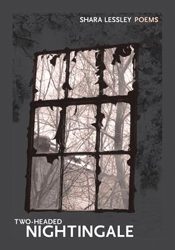
Shara Lessley’s excellent debut poetry collection, Two-Headed Nightingale, is full of performers, both human and non-human in variety. These poems feature exhausted ballet dancers, conjoined-twin singers, and early 20th century aerialists, not to mention flocks of birds (starling, sparrow, blackbird), plates of blue mussels, and a decomposing baleen whale. It may be hard to picture a whale rotting on the ocean floor as a kind of performance, but its “five tons of oil, sustaining / creatures by the hundreds” is oddly fitting for a collection in which people often sacrifice their own bodies in pursuit of artistry.
Lessley understands that sacrifice first-hand. She has a background in dance, and many of the early poems of Two-Headed Nightingale capture the torturous discipline that dancers must endure just to have a chance at performing. In “Act II: Costume Change” of the multi-part poem “The Old Life,” a dancer is injured during a class:
the ankle’s outer tendon
sent a sharp rush of heat up the Achilles,whose clipped strings jerked me, shrieking,
to the floor where they found me: darkbird—that for all its practice—could not
lift itself, somehow back out of the ashes.
This is the idea the subjects of these poems continually confront, the notion that practice, or craft, or determination, isn’t enough. These poems face down the failures: dancers’ bodies give way; a gifted aerialist falls to her death when a piece of brass on her trapeze snaps. And Lessley finds the art in these tragic, abrupt ends.
But it’s not just the dancers and acrobats who confront their limits. In “Captive,” the speaker watches as cicada trapped between the screen and the windowpane tries, in vain, to escape from “a death field // of insects: two bees, four flies, / a dark basket resembling a spider.” She cannot pry open the painted-shut window, so she does nothing, which is how the poem concludes:
I let it die, and it felt
good to let it. The death, proof of my consequence,or that I might be
capable of love, if only to withhold it.
The speakers in Lessley’s poems rest their gaze on the common cruelties we shy away from.
That willingness wouldn’t be so powerful if not for Lessley’s keen eye, especially in her observations of the natural world. Throughout the collection, she constructs vivid, cinematic images that rival the performances of her speakers. In “Portrait Hepialus,” she describes ghost moths “unthread[ing] nectar from orchids,” “burrowing into the heart of winter / legumes,” and “drilling / through century-old oak” into coffins. In “Wintering,” “panels of light make thirsty the ice- / caked stump of oak.” And in “Having It Out with God,” “a camp of bats surges from the open / mouth of sky.”
And when Lessley examines her own family history, her sharp eye becomes even sharper. These aren’t nostalgic poems; they’re exacting, unflinching reconstructions of Biblically harsh times. Two poems feature the speaker’s grandmother, a woman “making do” in the Depression-era South. “Field Song for Archey Valley in Her Mother’s Mother-Tongue” opens with a violent, dramatic scene:
In times of survival, there are no decisions
great or small—as a girl, my grandmother killed
a copperhead with a broomstick,
beating its pitted skull until her father’s dirt dampfloor shined bright as a penny. There was
no money.

Much is compressed into that handful of lines. We see the grandmother smashing the “pitted skull” of the copperhead and its dark blood shimmering on the floor. We know Lessley is a strong image-maker, but it’s the precise attention to language that drives this poem: the subtle movement from the “copper” in copperhead to the floor shining like a penny to the matter-of-fact statement that there’s no money for the family. That association propels the poem forward into the illness, hunger, and drought to come.
These poems often have devastating lines nestled inside them, waiting to be tripped like land mines. (It seems appropriate that Lessley’s second manuscript is tentatively titled The Explosive Expert’s Wife.) In “Field Song,” she flatly notes that “a husband will often turn / on his daughter before taking a second bride.” In “Photo of My Grandmother as Fieldworker, 1946,” she describes the scarred hands of a woman “that cannot // not feed her children.” There’s no safe spot to rest in Lessley’s poems; her lines can cut as quietly as a knife.
One of the final poems of the collection, “Prometheus as Sparrow,” describes a dead sparrow being torn apart by a crow, its “beak gashing / the breast’s tiny seam.” Two voices weave through the poem, one describing the scene, and one meditating on the event itself:
he who sways: the meat it hangs
above: will bend: beak unloosing:
then break: the gray entrails, guttingthis body, self: who needs
denial, myth we live and die by
Two-Headed Nightingale examines and unravels those myths: the ones “we live and die by.” Most of these performers, contrary to myth, don’t “make it.” The dancers are broken, the trapeze artists plunge to their death. But in a collection that opens and closes with poems about dead birds being torn apart, we don’t expect triumph. We expect hardship and trial. And that’s where the Lessley’s superb poetry comes from: the beauty and brutality of the ordeal.




